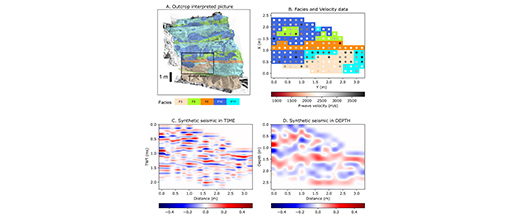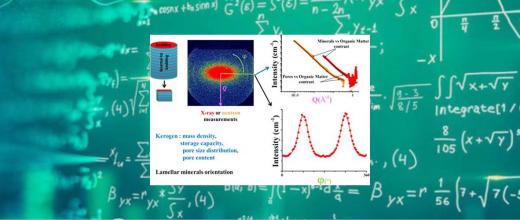Seismic imaging remains an important tool in the characterization of geological reservoirs. In the case of carbonate reservoirs, the biological origin of the sediments, as well as their transformation over time through diagenesis1, results in numerous structural heterogeneities.
The geological interpretation of seismic reflectors observed in these reservoirs can be extremely difficult due to the very small number of direct observations, generally limited to the exploration wells. Lateral variations in facies2 can thus lead to misinterpretation and result, for example, in the erroneous interpretation of fluid-rich zones.
One way to establish the link between geological facies and seismic signature is to study, at outcrop, rocks similar to deep carbonate reservoirs[1]. IFPEN is currently involved in a research project to study a lacustrine carbonate formation belonging to the Eocene Green River formation, in southwestern Wyoming (USA). An outcrop is being characterized at the metric scale, from a sedimentological and diagenetic point of view, in order to convert the various carbonate facies into seismic images (figure A), by measuring acoustic P-wave velocities3 (figure B).
A classical seismic modeling was performed, translating these velocities into seismic reflectors. This modeling is first carried out in the time domain and then converted into depth equivalent, using a velocity law derived from outcrop measurements. The difference between the time image (figure C) and the depth image (figure D) is representative of what can be observed on a large scale, in reservoir seismic. This time-to-depth conversion is of major importance, especially for very heterogeneous environments of this type in terms of wave propagation velocities.
Seismic reflectors are traditionally used in basin and reservoir modeling as surfaces corresponding to a same geological age (deposition or erosion). The study confirms, on a small scale, that this interpretation can prove to be erroneous, as a seismic reflector may correspond to a change of facies within the same geological deposit. Without detailed sedimentological knowledge of the imaged carbonate rocks, it is therefore possible to misinterpret these geophysical objects.
The study also demonstrates the importance of analog studies in the field, as the only way to obtain all the information necessary to relate geophysical data to sedimentological reality.
Click on the picture to enlarge

B: Discretization of the facies and outcrop speed measurements.
C: Synthetic seismic in time.
D: Synthetic seismic in depth.
1- Set of physicochemical and biochemical processes involved in the transformation of sediments into sedimentary rocks
2- The attributes of a sedimentary rock: set of lithological (mineralogy, geometry, sedimentary structure, etc.) or paleontological (fossil content) characteristics.
3- Elastic compression wave, the fastest propagating seismic wave in the rock.
[1] C. Bailly, J. Fortin, M. Adelinet, Y. Hamon. (2019). Upscaling of Elastic Properties in Carbonates: A Modeling Approach Based on a Multiscale Geophysical Data Set; Journal of Geophysical Research: Solid Earth, 124(12), 13021-13038.
>> DOI: 10.1029/2019JB018391
Scientific contact: Mathilde Adelinet






